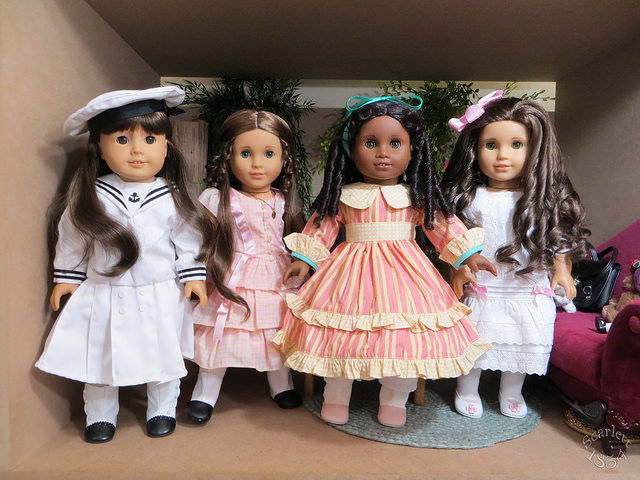The Company, which was bought by Mattel in 1998, has received criticism for dumbing down the brand, eliminating three of the five original American Girl Dolls, Felicity, Kristen, and Samantha. With each doll, there was a six book series, with a few more historically based books. Since then the remaining historical dolls have been relegated to the back page of the catalog, obscured on the website, and replaced by dolls that “look just like you” and the Girls of the Year dolls.
In this movement from the historical dolls, the brand has lost the educational aspect of the dolls, distilling their stories into conflicts that are so relatable they hardly warrant books written on them. While Felicity struggled with family and friends being on opposing sides of the American revolution, Saige, a modern doll, has problems with a diminishing arts budget. Talk about first-world problems.
But there’s another intriguing trend: Christianity is disappearing from the stories.
In the beginning, American Girl dolls came with a series of six books—one book introducing the girl, one where she learns a lesson, one when she celebrates Christmas, another of a birthday, another in the summertime, and a last book about a significant change. For years, the third book consistently featured a Christmas story. Since Mattel’s ownership of the company, there hasn’t been a doll with a Christmas Story since 2000.
Mattel can be congratulated for expanding the faith of their dolls—Rebecca Rubin, an immigrant Jewish girl from the turn of the century, was released in 2009. Yet the newly developed historical dolls—Kit (1940s), Marie Grace (1850s), Caroline (1810s), and Julie (1970), do not reflect the Christian nature of the times they existed in.
Even more interesting is the lack of religion in the “Girls of the Year”, American Girl’s modern dolls. All but one of these girls show a lack of faith background.
What does this all mean? While in some ways toys are just frivolous, and combing through toy-marketing strategies can seem overblown, there’s reason to believe this shift reflects an important aspect of our culture.
First, we know that toys influence a child’s sense of identity in profound ways. Studies show that girls between the ages of five to eight who are exposed to Barbie dolls feel worse about their bodies than girls exposed to dolls with more realistic physiques.
American Girl Doll can be given credit for the reasonable body proportions of their dolls. But shifts in the dolls stories can have tremendous impact on the girls that play with the dolls. The shift away from large-scale historical problems to minor, current, and local issues will have an impact on the girls. The shift of emphasis away from reading and historical analysis also influences the girls who play with these dolls. Finally, the minimization of Christian culture will have an impact on how these girls will regard their faith and the faith of people around them.
Some could say Mattel is trying to match the increased secularized culture of today’s world, and that may be true. But it’s missing the fact that Christian beliefs are still largely familiar background for American girls today. In fact 78.4% of Americans are Christian and that number has only been higher in the past. The brand can be applauded from recognizing faith traditions and reflecting the multicultural aspects of the American experience, but that has occurred at the expense of the Christian narrative.
A good example of this can be the story of historical doll Julie Albright. Julie is a doll from 1970s and her Christmas traditions are crushed by her parents’ new divorce, so she instead adopts the tradition of the Chinese New Year from her friend Ivy Ling.
Perhaps that story is a reflection of the times, with family fragmentation in modern society, many change their religion and traditions over their lives. It seems to be supported at least by Pew Research Poll, which indicates that more than a quarter (28%) of Americans left the faith they were raised in for another.
But Julie Albright’s story could just as well be a reflection of anti-Christian sentiment in the American Doll franchise. Why else would a brand that once placed emphasis on Christmas now airbrush any references to it in their stories? Why would it omit the traditional holiday that the majority of American girls continue to celebrate—the very holiday, in fact, that Mattel is banking on parents celebrating with their children, enough to go buy and place a doll under the Christmas tree?
One thing’s for sure: The original American Girl dolls reflected the Christian nature of American culture, and Mattel’s new historical girl dolls are devoid of all Christian belief. There’s reason to believe this is not just a reflection of modernity but that the new strategy itself is also an assertion of norms. Some of these norms—multiculturalism and an acceptance of different spiritual beliefs—are welcome additions. But Mattel is mistaken when it thinks it needs to eliminate the Christian perspective in order to include other faiths.
Rachel Miklaszewski hails from Chicago and is a self-proclaimed feminist and a Catholic from birth. She is a political science senior at the George Washington University.
Photo credit: Eileen Neylon






1 Comment